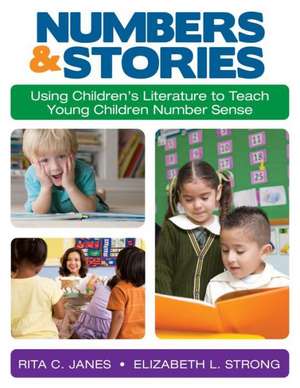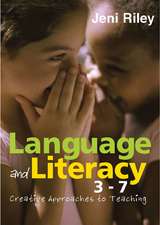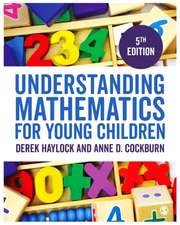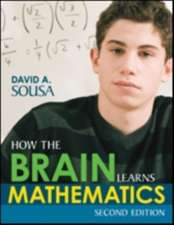Numbers and Stories: Using Children's Literature to Teach Young Children Number Sense
Autor Rita C. Janes, Elizabeth L. Strongen Limba Engleză Paperback – 18 iun 2014
Math and reading go hand in hand, especially among young children who are new to both. If you’re looking for a way to build number sense and reading skills at the very same time, rely on this indispensable resource. Using children’s books as a springboard for learning, it provides 22 detailed lessons, all ready for immediate implementation.
The authors--one an internationally respected Mathematics professional development consultant, the other a language arts specialist--provides ideas and support to combine children’s literature with meaningful mathematical learning experiences. The book includes:
- 22 interactive, research-based investigations with detailed instructional suggestions and problem-solving tasks
- High-quality children’s book selections
- Reflection and discussion questions and prompts for both teachers and students
- Children’s work pages and formative assessment tools
- An online facilitator’s guide
Preț: 317.43 lei
Nou
Puncte Express: 476
Preț estimativ în valută:
60.74€ • 64.95$ • 50.64£
60.74€ • 64.95$ • 50.64£
Carte tipărită la comandă
Livrare economică 17 aprilie-01 mai
Preluare comenzi: 021 569.72.76
Specificații
ISBN-13: 9781483330945
ISBN-10: 148333094X
Pagini: 224
Dimensiuni: 216 x 279 x 15 mm
Greutate: 0.64 kg
Ediția:New.
Editura: SAGE Publications
Colecția Corwin
Locul publicării:Thousand Oaks, United States
ISBN-10: 148333094X
Pagini: 224
Dimensiuni: 216 x 279 x 15 mm
Greutate: 0.64 kg
Ediția:New.
Editura: SAGE Publications
Colecția Corwin
Locul publicării:Thousand Oaks, United States
Recenzii
“This a great topic. With the push for application of math concepts to prepare for Common Core, this text will be a useful resource for teachers.”
“Teachers will find that this book enhances their math programs aligning problem solving to the Common Core. It provides teachers the opportunity to “dig deeper” into the number sense math content, which is the basis of the Common Core.”
“This book is unique in that it provides specific lessons and activities for specific books in children’s literature.”
“The ready to teach lessons, proposed activities, researched-based strategies and techniques would be a welcome asset to teachers.”
“Teachers will find that this book enhances their math programs aligning problem solving to the Common Core. It provides teachers the opportunity to “dig deeper” into the number sense math content, which is the basis of the Common Core.”
“This book is unique in that it provides specific lessons and activities for specific books in children’s literature.”
“The ready to teach lessons, proposed activities, researched-based strategies and techniques would be a welcome asset to teachers.”
Cuprins
Preface
Acknowledgments
Publisher's Acknowledgments
About the Authors
I. Here's the Story: Fundamental Components for Developing Number Sense Using Children's Literature
1. The Young Child and Mathematics
Why Mathematics for Young Children?
Learning Mathematics in the Early Years
2. The Learning Environment
Features of the Learning Environment
Summary
3. Why Integrate Children's Literature and Mathematics?
Children's Literature and Learning Mathematics
Reasons for Integrating Children's Literature and Mathematics
Summary
4. Essential Features of the Investigations
Design of Investigations
The Context
Important Mathematics
Supporting Children's Learning
Summary
5. Design of the Investigations
Stages of Investigations
The Six Stages
Summary
II. Children's Literature and Number Sense Investigations
Unit 1: Counting and Cardinality
Cardinal Numbers One to Ten - The Water Hole (Graeme Base)
Subitizing - Olly and Me: 1 2 3 (Shirley Hughes)
Counting On - Mouse Count (Ellen Stoll Walsh)
Counting to Find How Many - How Many Snails? A Counting Book (Paul Giganti Jr.)
Counting Backwards - Ten Little Fish (Audrey Wood)
Unit 2: Whole Number and Operations Relationships
Comparing Quantities and Numbers - One Big Building: A Counting Book About Construction (Michael Dahl)
Comparing Numbers - How Many Snails? A Counting Book (Paul Giganti Jr.)
Numbers That Make 10 - Ten Flashing Fireflies (Philemon Sturges)
Odd and Even Numbers - 365 Penguins (Jean-Luc Fromental)
Skip Counting by 2s, 5s, and 10s - Two Ways to Count to Ten: A Liberian Folktale (Ruby Dee)
Doubling Numbers - Minnie's Diner: A Multiplying Menu (Dayle Ann Conrad)
Equal Groups - How Do You Count a Dozen Ducklings? (Sean Chae)
Unit 3: Operations and Algebraic Thinking
Equality and Equations - Balancing Act (Ellen Stoll Walsh) and Equal Shmequal (Virginia Kroll)
Decomposing Numbers/Word Problems - Quack and Count (Keith Baker)
Add Within 20 - The Tub People (Pam Conrad)
Subtraction Within 20/Word Problems - What's the Difference? An Endangered Animal Subtraction Story (Suzanne Slade)
Add Two or More Addends - The Twelve Days of Summer (Jan Andrews)
Unit 4: Operations Within 100 and Place Value
Representing Numbers to 100/Addition and Subtraction - One is a Snail, Ten Is a Crab: A Counting by Feet Book (April Pulley Sayre & Jeff Sayre)
Addition and Subtraction Within 100/Word Problems - The Centipede's 100 Shoes (Tony Ross)
Numbers 10 to 19/Place Value - Let's Count (Tana Hoban)
Numbers 20 to 100/Place Value - Let's Count (Tana Hoban)
Appendices
Appendix A (1-4) - Unit 1: Counting and Cardinality
Appendix B (1-12) - Unit 2: Whole Number and Operations Relationships
Appendix C (1-5) - Unit 3: Operations and Algebraic Thinking
Appendix D (1-8) - Unit 4: Operations Within 100/Place Value
Appendix E (1-2) - Duplicated Appendices
Appendix F - Learning Expectations Correlation Chart
References
Bibliography of Children's Literature for the Investigations
Index
Acknowledgments
Publisher's Acknowledgments
About the Authors
I. Here's the Story: Fundamental Components for Developing Number Sense Using Children's Literature
1. The Young Child and Mathematics
Why Mathematics for Young Children?
Learning Mathematics in the Early Years
2. The Learning Environment
Features of the Learning Environment
Summary
3. Why Integrate Children's Literature and Mathematics?
Children's Literature and Learning Mathematics
Reasons for Integrating Children's Literature and Mathematics
Summary
4. Essential Features of the Investigations
Design of Investigations
The Context
Important Mathematics
Supporting Children's Learning
Summary
5. Design of the Investigations
Stages of Investigations
The Six Stages
Summary
II. Children's Literature and Number Sense Investigations
Unit 1: Counting and Cardinality
Cardinal Numbers One to Ten - The Water Hole (Graeme Base)
Subitizing - Olly and Me: 1 2 3 (Shirley Hughes)
Counting On - Mouse Count (Ellen Stoll Walsh)
Counting to Find How Many - How Many Snails? A Counting Book (Paul Giganti Jr.)
Counting Backwards - Ten Little Fish (Audrey Wood)
Unit 2: Whole Number and Operations Relationships
Comparing Quantities and Numbers - One Big Building: A Counting Book About Construction (Michael Dahl)
Comparing Numbers - How Many Snails? A Counting Book (Paul Giganti Jr.)
Numbers That Make 10 - Ten Flashing Fireflies (Philemon Sturges)
Odd and Even Numbers - 365 Penguins (Jean-Luc Fromental)
Skip Counting by 2s, 5s, and 10s - Two Ways to Count to Ten: A Liberian Folktale (Ruby Dee)
Doubling Numbers - Minnie's Diner: A Multiplying Menu (Dayle Ann Conrad)
Equal Groups - How Do You Count a Dozen Ducklings? (Sean Chae)
Unit 3: Operations and Algebraic Thinking
Equality and Equations - Balancing Act (Ellen Stoll Walsh) and Equal Shmequal (Virginia Kroll)
Decomposing Numbers/Word Problems - Quack and Count (Keith Baker)
Add Within 20 - The Tub People (Pam Conrad)
Subtraction Within 20/Word Problems - What's the Difference? An Endangered Animal Subtraction Story (Suzanne Slade)
Add Two or More Addends - The Twelve Days of Summer (Jan Andrews)
Unit 4: Operations Within 100 and Place Value
Representing Numbers to 100/Addition and Subtraction - One is a Snail, Ten Is a Crab: A Counting by Feet Book (April Pulley Sayre & Jeff Sayre)
Addition and Subtraction Within 100/Word Problems - The Centipede's 100 Shoes (Tony Ross)
Numbers 10 to 19/Place Value - Let's Count (Tana Hoban)
Numbers 20 to 100/Place Value - Let's Count (Tana Hoban)
Appendices
Appendix A (1-4) - Unit 1: Counting and Cardinality
Appendix B (1-12) - Unit 2: Whole Number and Operations Relationships
Appendix C (1-5) - Unit 3: Operations and Algebraic Thinking
Appendix D (1-8) - Unit 4: Operations Within 100/Place Value
Appendix E (1-2) - Duplicated Appendices
Appendix F - Learning Expectations Correlation Chart
References
Bibliography of Children's Literature for the Investigations
Index
Notă biografică
Descriere
Using children’s books as a springboard for learning, this book provides 22 ready-to-use lessons that teachers can use to build number skills and improve literacy at the same time.







